my first blooms!!
I just got to see blooms on the first rose of the year! It's on a potted rose I got this year, my flowers in the ground will start in a week or so! It's Sophies Perpetual from Burlington!
Comments (61)
Related Professionals
Fort Lee Landscape Architects & Landscape Designers · Matthews Landscape Contractors · Englewood Landscape Contractors · Forest Hills Landscape Contractors · Fort Worth Landscape Contractors · Fridley Landscape Contractors · Indianapolis Landscape Contractors · Lewisville Landscape Contractors · Nanuet Landscape Contractors · New Brighton Landscape Contractors · Rancho Santa Margarita Landscape Contractors · Cedar Hill Swimming Pool Builders · East Brunswick Siding & Exteriors · Oregon City Siding & Exteriors · San Antonio Siding & Exteriorsstrawchicago z5
11 years agolast modified: 9 years agoThank you, Alana, for posting more great pics. I love them all. Your last pic. of Reine DV shows lighter young leaves with dark veins .... clearly iron deficiency.
Burlington in California has alkaline tap water. Roseseek (Kim Rupert) explained how CA get their water, the rivers and the municipal practice involved.
pH of rain is 5.6 and even lower by the East coast. However, pH of tap water in CA is alkaline, ranging from slightly alkaline (where Kippy is), and very alkaline at 8 (where Jeri, Kim, and Burling are).
Last year I got a band of Mirandy from Burlington, leaves all whitish yellow ... She explained that it's nitrogen deficient from too much rain. I gave it blood meal and it greened up immediately.
Your pics. look more like iron deficiency from alkaline tap water. Fastest way to green up? Put them in either potting soil made for acid-loving plants, or garden soil made for Azaleas and Camellias.
It's good to boil some red cabbage in your tap water, then another batch of red cabbage in distilled water ... this should turn violet. If your tap water turns blue, then it's alkaline. If your tap water is the same color as the red cabbage in distilled water, then it's neutral.
I achieved dark green leaves last year by soaking used lemon rinds in my pH of 8 tap water. I notice that when my pots get spring rain, leaves are dark green and bloom tons. When my pots get my alkaline tap water, leaves become pale and less blooms.
I don't recommend putting garden sulfur on the top of soil. Acidic wet surface breeds fungi, and you'll get black spots. I don't recommend putting alfalfa meal or pellets either ... its pH is 5.8 to 6 ... my pots with that sticky acidic stuff broke out in BS.Alana8aSC
Original Author11 years agolast modified: 9 years agoThey are potted up strawberryhill, so what would my next best course of action be? the fastest easiest organic choice of course?! Thanks for any help you can give me on this! I did give them alfalfa pellet though, just a little mixed in with the potting mix, everyone else loved it! Help me on this please! would another folier spray of fish emulsion help?
strawchicago z5
11 years agolast modified: 9 years agoHi Alana: I'm glad that you mix alfalfa into the soil. Alfalfa NPK is 2-1-2, with growth hormone. Two University Extensions documented yellowing, chlorosis, with alfalfa pellets ON TOP. Why? It's gunky and blocks out oxygen from above.
Fish emulsion is very acidic, best mix into your tap water to lower the pH for pale roses. It's great to water your roses with diluted fish emulsion, but NOT to spray the foliage. If leaves are kept wet and slightly acidic, you'll get diseases.
Fish emulsion is cited as NPK is 5-2-2, with trace elements. Below link shows a University of Mass. research on marigolds grown on chemical, fish emulsion, alfalfa pellets, or a combo. They compared Neptune fish emulsion NPK of 3-1-5, versus chemical fertilizer NPK of 20-2-20.
Personally I think the marigold watered with fish emulsion looks best... it looks really dark green, so you are on the right path.
Another organic way is to use blackstrap molasses, but only the Plantation brand has the highest nutrient.
Plantation brand sold at Walmart has 17% potassium, 20% iron, and 20% calcium. Experiments on Soluble fertilizers showed that high potassium plus calcium yielded the best root growth, and the best flowering.The high iron in Plantation Blackstrap molasses will green up your plants. Here's the link to nutrients in different brands of molasses ... they vary widely:
http://www.davidwalbert.com/2010/08/20/whats-really-in-the-molasses/
Here is a link that might be useful: U. of Mass experiment with marigolds
Alana8aSC
Original Author11 years agolast modified: 9 years agoThanks Strawberryhill!,
Will the mix be the same with the black molasses? 1-2 tables spoons like with the fish emulsion? I'll get some of that untill them I'll give them some fish emulsion. Thanks!
strawchicago z5
11 years agolast modified: 9 years agoLess is best with molasses. People with green plants use 1/2 teaspoon per gallon of water for every 2 weeks. Since roses are tougher, 1 teaspoon would be fine. Too much sugar can make the fungi out-number the bacteria in the soil.
A tiny bit of sugar stimulates the endo/ecto mycorrhizal fungi. That group of soil fungi increase the nutrients in soil, esp. phosphorus, potassium, and iron. I posted a thread on mycorrhizal fungi a month ago.
I use Jobes' organic fertilizer for tomatoes NPK 2-7-5 for my pots ... it has mycorrhizal & bacteria added. Cheapest way is to add a tiny bit of native soil to the pots, for beneficial bacteria and fungi. Someone reported good success putting a few earthworms in the pots.
Here is a link that might be useful: Rating of different brands of molasses
This post was edited by Strawberryhill on Fri, Apr 19, 13 at 17:01
strawchicago z5
11 years agolast modified: 9 years agoSusan (poortbutrichrose) once asked me about kelp meal. I warned her about its high-salt, but forgot to mention that kelp meal has all the micronutrients like iron, zinc, manganese, copper, boron ... which are most deficient in alkaline condition. Green sand also has all the micronutrients, so does horse manure.
Below is the best chart for nutritional deficiencies ... you'll see what nutrients are missing at what pH range. Clay soil is quite fertile, less is best. Sandy soil needs more, since nitrogen leaches with water.
Here is a link that might be useful: Cornell University chart on nutrient deficiencies
Alana8aSC
Original Author11 years agolast modified: 9 years agoThanks Strawberryhill, I've been doing the fish emulsion, but it don't seem to be helping so I will try the try the molasses the month. Thanks for the continuing posting of great advice! I got more flowers on the verge of opening, but they are making me impatient..they are taking their sweet time!
strawchicago z5
11 years agolast modified: 9 years agoHi Alana: I don't know how much iron fish emulsion has. However, the regular MiracleGro potting soil (green bag) is most acidic at pH 6.5 .... I grow super-dark-green geraniums in that soil, compared to other potting soils. If you can lower the pH of your tap water to the same as rain water, then nutrients would not be tied up at that high pH level.
There are ways to lower the pH of your tap water to the same as rain pH (5.6). Some people put a tiny bit of apple cider, or citric acid. Citric acid is used in sprouting, sold at the health food store. I tried to sprout my own broccoli sprout, no luck with my tap water over pH 8 ... My Mom sprouts her own beansprout easily, but her tap water is neutral pH.
If the pH of your water is alkaline, plants don't root well, less root means less flowers. Some municipals add lime to tap water so pipes won't corrode. Lime in tap water drives down potassium, necessary for blooms and root growth.
It's worth it to boil your tap water with red cabbage, so you know how much acid to add to get the same color as red cabbage boiled in rain water.
Besides molasses, kelp, and green sand, cocoa mulch also has high potassium and all trace elements. Cocoa mulch is best mixed AT THE BOTTOM of the planting hole, and water-in well, so dogs can't eat, and won't get sick. Here's the nutrients in cocoa mulch, sold at Menards for $3.45 for a huge bag (only $1 more expensive than mulch).
Cocoa mulch is poisonous to pets. But once watered in well, the chocolate smell goes away, and pets are no longer interested. Best mixed at the bottom of the hole.
ANALYSIS OF COCOA MULCH at pH 5.4
Total N % 3.0
Total C % 43.0
Phosphorus mg/100g 1000
Potassium mg/100g 3251
Calcium mg/100g 575
Magnesium mg/100g 488
Iron mg/100g 140
Manganese mg/100g 9
Zinc mg/100g 11
Copper mg/100g 3.5
Nickel ppm 1.0
Here is a link that might be useful: Nutrients in Cocoa Mulch, pH 5.4
This post was edited by Strawberryhill on Mon, Apr 22, 13 at 17:26
Alana8aSC
Original Author11 years agolast modified: 9 years agoI just found something called iron tone. Do you think it will work? I already use rose or plant tone foe a fertilzer along with alfalfa pellets, alternating them ofcourse.
zeffyrose
11 years agolast modified: 9 years agoYour pictures are beautiful----the lighting shows off the roses beautifully----
Since I love pearls and roses I would really love to have White pearl in red dragon's mouth----I will have to check to see how it would grow in my area--thanks for your lovely pictures-
Florence
strawchicago z5
11 years agolast modified: 9 years agoHi Florence: I'm glad to hear from you ... always love your graciousness and kindness.
Hi Alana: Iron tone NPK is 2-1-3, with 5% iron, and 13% sulfate. It looks like iron sulfate to me, which I had experimented with BAD results, killed 1 of my rhododendrons, burnt my 2 white pines, and almost killed my favorite azalea.
Iron is best in chelated form. MiracleGro SOLUBLE rose food has both chelated iron and chelated manganese. My roses are dark green with that MG stuff NPK 18-24-16. Drawback? High nitrogen attract pests (aphids, mites, thrips). Use with caution. High chemical nitrogen is also high in salt. Salt index of urea is 74%, salt index of ammonium sulfate is 88.3%. It's like dumping salt on your rose bush.
When I researched on iron sulfate (Iron Tone), folks in the Rose Forum gave it thumb up. So I bought it, but it burnt my plants ... Then I researched further and found University of Arizona stating that Iron Sulfate is useless at above pH 7. Another site said iron sulfate burns roots.
The safest bet? To lower the pH of your tap water to that of rain water. My roses in pots are dark green with spring rain, but when I give it tap water in hot summer, they become yellowish (chlorotic). My tap water pH is over 8, which locks up both phosphorus and potassium for blooms, plus micronutrients such as iron, manganese, boron, and zinc.
I was reading through EarthCo. booklet on soil management. They recommend mixing peat moss with the top layer of soil to lower pH. I haven't experimented with it, so I can't recommend it. pH of peat moss is 4, so it might lower the pH of tap water passing through.
Peat moss on top can block out water, so it's best mixed in lightly. Peat moss doesn't burn like sulfur granules. After seeing how iron sulfate burnt plants' roots, I'm cautious with anything ending with sulfate. The acid fertilizer was caustic to my skin, if I don't wash it off immediately. It also killed earthworms. Peat moss is safe, since it's slow-acting and retains water.
I post the link to Cornell University chart again, showing what nutrients are deficient at what pH range. Roses are dark green at pH 6 to 7, where nutrients are released. Anything beyond that range result in nutrients being tied up.
Here is a link that might be useful: Cornell University chart on nutrient deficiencies
This post was edited by Strawberryhill on Tue, Apr 23, 13 at 10:47
Alana8aSC
Original Author11 years agolast modified: 9 years agoThanks Strawberryhill, will just try the molasses next month!
strawchicago z5
11 years agolast modified: 9 years agoI found a thread in bringing the pH of water down for the fish in the below forum:
"I have ultra alkaline, ultra hard well water. It has a ph somewhere between 8.2 and 8.6 I believe. Hardness and alkalinity, I am told, are off the chart (my local fish store).
Not all plants and fish like that awful stuff. For one, my corydoras catfish can't stand it. I just dropped my ph down to about 6.2 or 6.4 simply by pouring my water through my homemade peat filtering system, with peat moss."
See below link on how to use peat moss to lower water pH:
Here is a link that might be useful: Use peat moss to lower water hardness
strawchicago z5
11 years agolast modified: 9 years agoHi Alana: I applaud you for going organics, rather than using chemicals. See below post for the danger of using Ironite, or iron disulfate:
•Posted by texasgardener_2010 (My Page) on
Sun, Nov 21, 10 at 12:05Please see my post that my large mix-breed dog was diagnosed and died of cancer after I used Ironite in my yard for two summers preceding his diagnosis. He was only 6 years old when he died of cancer. Ironite has arsenic that is known to cause cancer. Government studies show its arsenic and lead levels exceed government safety standards but somehow it's still on the market. Don't use it or other chemical herbicides/pesticides. Protect your family, children, pets. Medical studies on these chemicals make the link clear to cancer. Go organic before it's too late.
Alana8aSC
Original Author11 years agolast modified: 9 years agoThanks Strawberryhill, I love using organic.Ever since I started last year m roses have looked so much better! Thanks for the information you keep sending. If the molasses don't work I'll try the chelated iron next. I'm just not sure where to get it, I'll look that up today!
Alana8aSC
Original Author11 years agolast modified: 9 years agoI mixed peat moss in with the potting soil though, shouldn't that had helped?
strawchicago z5
11 years agolast modified: 9 years agoHI Alana: That would help, except peat moss decomposes quickly and loses its acid-power. Pine bark retains its acid-power for MUCH longer.
I did pH testing with red-cabbage juice on 10 samples (a few types of potting soil, and mixing with peatmoss, pine bark, and cocoa mulch) .... I reported the result in Susan's thread "Care of band Hybrid Perpertuals"
Today I received 11 bands from Burlington Roses, including Excellenz von Schubert (lots of blooms, smell great). A bit pale, but not bad.
There are many pale ones: Double Delight (an iron-hog), Lauren, Too Cute, Excellenz Von Schubert, Marie Daly .... Lots for me to experiment ... will let you know once I get them green up.
I received 2 Gina Roses last week and put one in MG Moisture Control potting soil, the other one in Ball's Potting soil (composted pine barks). We have constant rain for the past weeks. The Gina rose in the MG Moisture Control is very yellowish, the Gina rose in the Ball's potting soil is more green.
I also received Eye-for-You rose which I put in MG Moisture Control, the new growth are VERY yellow. Last year I made 2 different holes: One hole with tons of peat moss, very much like MG Moisture Control. Sonia Rykiel was yellowish for a long time, even when I gave it blood meal with chelated iron. The other holes have tons of pine mulch ... both roses Firefighter and Sweet Promise are dark green.
With potting soil with peat moss: When constantly wet, it expands, resulting in roots choking... plants can't get much oxygen nor nitrogen without air space. With composted pine bark, it's fluffier, more air space, and plants are more efficient in getting both oxygen and nitrogen. Air is composed of (by volume) 78.09% nitrogen, 20.95% oxygen, and 0.039% carbon dioxide.
Susan (poorbutrichrose) reported chlorosis on her rose planted in MG moisture control (mostly peatmoss), plus Mill's Magic (mostly fine particles). Rose Tone is made of very fine particles (alfalfa meal, bonemeal, other meals).
When the particles are small like alfalfa meal and peat moss, they expand when wet, become sticky, and either gunk up on top, blocking oxygen ... or else too dense for roots to breathe. My clay is very dense, and my acid-plants like azaleas and rhododendrons became more yellowish when I gave it acid fertilizer high in nitrogen.
The physical structure of the soil is just as important as the chemical composition. Kittymoonbeam is ahead of me when she used pumice sand (coarse sand) for her pots. The blueberry site recommended using pumice sand TOGETHER with peatmoss, so it won't gunk up.
Yellowing, or chlorosis can be caused by air being choked out, when small particles expand when wet. That's why two University Extensions reported chlorosis with alfalfa on top. Alfafa expands when wet, even stickier than peat moss.
Below is a picture of Sonia Rykiel leaf, very yellowish from planting in 1/2 peat moss mixed with heavy clay, plus gobs of alfalfa meal. Compare that to the dark green leaf of Golden Celebration planted in fluffy horse manure (pH over 7.4). Golden Cel. is dark green, but doesn't bloom much at that high pH.
This post was edited by Strawberryhill on Wed, Apr 24, 13 at 21:25
User
11 years agolast modified: 9 years agoHow funny. I snipped a Sophie's Perpetual bloom this evening for a bud vase. I love having one nearby for sniffing. This is a new one for me, too.
Chlorosis is a problem caused by lack of iron and/or alkaline soil. The soil could have plenty of iron, but if the Ph is too alkaline, the plant won't be able to take up the iron. If you can't do a soil analysis or determine the Ph, then the simplest thing would be to treat for both problems.
You could try Ammonium Sulfate. I have found bags of that in the organics section of home improvement stores. The brand name was Espoma.
Something else not quite organic but effective would be looking for a fertilizer designed for acid-loving plants like Azaleas and Camellias. (It used to be called Miracid, but I think it's called something else now.)
I've also heard sprinkling used coffee grounds or used tea leaves around the base of the plant is also supposed to help acidify the soil if it's too alkaline.
jerijen
11 years agolast modified: 9 years agoYes, Azalea/Camellia food is helpful.
But one thing I have found helpful and effective is soil sulfur. I'll drop a bit of that where the water will run over it, and it makes a difference.
Don't try to do TOO much until your babies mature a little.
Too much fertilizer of any sort can be harmful with newly-planted roses. Wait until you have them planted, and see some growth going on, and even then, start slow.BTW -- The REAL standard-setter HERE for chlorosis was always 'Reine des Violettes.' I've seen her with WHITE leaves.
One of the things I love about "Pulich Children" and "Forest Ranch Pom-Pom is the fact that they are poiple roses that do not have chlorosis problems here. FRPP is much like RdV in color -- "fading" more and more lavender as the blooms age, before they gently shatter.
Jeri
Alana8aSC
Original Author11 years agolast modified: 9 years agoThanks Jeri and Bellegalica, they are in pots right now, so I'm trying not to add to much of anything to them. I tried so far fish emulsion, and I did place a used tea bag in their, maybe I should just put a dry one? Next I'm trying the molasses and them maybe a sprinkle of sulfur. I may wait until they are in the ground to try the sulfur though.
strawchicago z5
11 years agolast modified: 9 years agoHi Alana: Jeri mentioned "drop a bit of that where the water run over", regarding sulfur. In another thread Jeri explained how she put sulfur in her watering system.
Thanks, Jeri, for that great pic. of Forest Ranch PP.
SULFUR BURNS ROOT IF APPLIED DIRECTLY TO THE SOIL ... many sites warned on this. I burnt my azaleas and rhododrendrons, using acid fertilizer. The pH of tea is 7.2, doesn't help. I tested coffee grounds on my acid-plants. Coffee grounds work as a buffer, you'll see it when you test in red cabbage.
I tested espresso grounds from Starbucks ... that's a bit too strong, and I got pink stripes on my rhodies. Espresso has higher caffeine than coffee
I tested watering with SOLUBLE fertilizer high in ammonium sulfate... that didn't work either, since Schultz doesn't have CHELATED iron and manganese like MiracleGro. Draw back? The salt-index of ammonium sulfate is 88.3. That's the first time in 12 years that I had to water my acid-plants.
I also used acid fertilizer (with ammonium sulfate) on that multiflora rose that came down with RRD. The salt in chemical nitrogen worsened the drought, the acid injured its roots, then came the soft new growth that fed the mites that caried the RRD virus.
One safe way is to CHANGE the physical structure of your soil. Mix in some perlite to fluff up for air, or mix in small pine mulch, if you want to lower the pH plus aerate.
Once my acid-plants are done blooming, I'll dig them up and fix them by mixing pine mulch and cocoa mulch (NPK 2.5-1-3 with all trace elements). There was tons of earthworm where I tested cocoa mulch in a hole, like 10+ worms per scoop! Earthworms aerates and fluff up the soil, plus supply nitrogen via their manure.
Another way is to put pine-mulch on top of your pots. The pH of pine mulch is around 4.5. I picked up a piece of 2-years old pine mulch, and tested in red cabbage ... it turned medium pink, quite acidic.
Warning: In my last house with acidic clay, mulched with pine, I had the worst black spots. I ought to try putting horse manure on top of pine mulch!!
Yellowing could be cause by either alkaline tap water, or by peat moss and alfalfa expanding when wet, choking out roots. I'm looking at Basyes Blueberry rose now, it's in 1/2 peat moss mixed with my clay, plus alfalfa meal... we have constant rain. That rose is yellowish when wet, no matter what's the pH.
Acid-fertilizer high in nitrogen did not green up Sonia Rykiel's leaf posted earlier. It was blood meal with chelated iron that fixed Sonia ... her leaves became green, but she bloomed less with too much nitrogen.
I re-post the link to what I wrote on how to get the pH of anything using $1.50 worth of red cabbage and distilled water.
Here is a link that might be useful: Cheapest way to test soil pH using red cabbage
This post was edited by Strawberryhill on Thu, Apr 25, 13 at 11:44
strawchicago z5
11 years agolast modified: 9 years agoI forget to ask Alana: Do you have clay, loamy, or sandy soil? Jeri's soil is NOT clay like mine, so sulfur in water works well for her.
Alkaline clay like mine can't be fixed with acid alone. Plants are made worse with sulfur, which cause root injury. My clay is tested very high in magnesium. According to EarthCo.'s booklet, "Magnesium limit the availability of potassium, zinc, boron, and manganese." Magnesium is what makes clay soil sticky like glue.
Manganese is diffused, rag-edged yellowing, which is worse looking than iron-deficiency. That can be fixed by structural change of the soil, and not by chemical means.
My soil is also tested deficient in potassium, iron, and manganese. Bringing down the pH is NOT enough for clay soil, one has to fluff up the soil for nitrogen and oxygen availability.
Peat moss and alfalfa act like clay due their fine particles and stickiness. No matter what's the pH, it's still yellow if there's NOT enough bigger particles like coarse sand, perlite, pine fines, or organic matter for aeration and root expansion.
This post was edited by Strawberryhill on Thu, Apr 25, 13 at 11:08
ingrid_vc so. CA zone 9
11 years agolast modified: 9 years agostrawberryhill, my Blue Mist looks just like yours, with nice dark green leaves even in my alkaline soil, so I must be doing something right. I love the way yours looks in the pot; it seems like the perfect plant to use that way.
Ingrid
strawchicago z5
11 years agolast modified: 9 years agoHi Ingrid: I treasure your input. You confirmed my suspicion that the gunking soil has more to do with yellowing, than pH alone. Pots and sandy soil also needs more nitrogen than roses in clay or loamy soil.
Did you notice how dark-green the Golden Cel. leaf posted in fluffy horse manure, at pH over 7.4? Horse manure is high in iron, plus all the micronutrients.
Ingrid's soil is decomposed granite, high phosphorus, potassium, plus all the trace elements. Ingrid's soil is loose and fluffy, which allows root expansion for maximum nitrogen uptake. Both nitrogen and iron is required for plants to green up. Here's info. on Ingrid's soil:
"Granite dust (0-0-6) Widely used to remineralize soil with
micronutrients and potassium. Releases nutrients very slowly."If the potting soil has too much peat moss and alfalfa gunking inside, roots can't access neither oxygen nor nitrogen. When the soil is wet, the fine particles glue up. The acid-plants in my clay soil become yellowish when we have too much rain, because roots can't breathe in water-logged clay. When it's drier, they are green again.
That's why composted-pine potting soil is better than peat-based potting soil for high rain climate. Jeri's tap water pH is 8, my hard well-water is above 8, so lowering the water pH helps. Lowering the pH of the soil doesn't solve the problem if one has sticky clay, or gunk up peat moss and alfalfa.
I already lost $50 worth of azaleas & rhododendrons by experimenting with acid fertilizer. Another 2 plants are near-death. Clay soil retains salt in chemical nitrogen, and acid burns more .. versus chemicals get flushed out of sandy soil easier. If you have clay soil like mine, organics is the best way, it's slow-released, and less salt.
This post was edited by Strawberryhill on Thu, Apr 25, 13 at 13:44
Alana8aSC
Original Author11 years agolast modified: 9 years agoWe have sandy soil on top and orange/red clay underneath, but that wouldn't have nothing to do with this, because they are potted up. I potted them up using the same recipe for like 40 roses and like four are doing this. In the potting mix I used potting soil ( cheap regular stuff ), humas/ manure mix ( just a small amount compared to potting soil) , peat moss, bone meal, alfalfa pellets, rose tone, and a small amount of scotts top soil mix that to gather well. them I topped them off with alittle top soil, and then some mulch. I forgot to add it drains very well.
This post was edited by Alana7bSC on Thu, Apr 25, 13 at 13:46
strawchicago z5
11 years agolast modified: 9 years agoThank you, Alana, for the info. That sounds like what I did to my 20+ pots last summer, except I didn't put manure or bone meal. I also put top soil on top of some pots .... these get the worse yellowing (oxygen can't go through that thick soil).
All my pots drained well: I drilled lots of holes at the sides. Pots need ultra-loose-and-fluffy soil, otherwise plants won't do well. I see a big difference in the denser MG Moisture Control potting soil versus the loose, bigger particle composted pine .... plants are darker green.
The problem with putting too much organics like peat moss and alfalfa meal is: they consume nitrogen when they decompose, so your pots become deficient. Peat moss has zero nutrient, both manure and alfalfa meal has very little nitrogen. NPK of alfalfa is 2-1-2.
Pots drain well, so nitrogen leaches with water. Nitrogen mobility is a 10. Blood meal with chelated iron might help NPK 12-1-0. Just a tiny bit, otherwise you'll get pests, shallow root, and no flowers.
For the acid-loving roses: Reine des Violettes, Excellenz von Schubert, it might help to put some pine mulch on top, if you can't mix into the soil.
It's worth it to check the pH of your tap water. It takes 10 minutes to boil some red cabbage in 1 cup distilled water, versus some red cabbage in your tap water. Compare the results: If your tap water is really blue, then it's very alkaline. Acid-loving and most multiflora roses prefer neutral water and loose soil.
Alana8aSC
Original Author11 years agolast modified: 9 years agoThanks Strawberryhill! Didn't think about the nitrogen leaching away! this is only my second time potting up plants before setting them out in the ground!and last time I didn't have so many! Will try that advice, Thanks!
strawchicago z5
11 years agolast modified: 9 years agoHi Alana: I did some detective work as to why the 11 bands I received from Burlington this week have pale leaves, on the multiflora and polyantha ones. I asked Burling what fertilizer she uses this year: she uses Oscomote.
Last year she used slow-released MiracleGro plus MiracleGro SOLUBLE fertilizer fortified with iron, manganese, zinc, copper. So the 14 bands I received last year were all dark green.
A fertilizers study done by a University Extension listed Oscomote as leaching the most nitrogen. Then I found this quote by a guy who wrote to Scotts regarding Oscomote, and they confirmed "you are missing iron, manganese, and zinc in your Osmocote."
The same guy wrote: "I am currently testing 10-10-10 against Miracle Gro Shake'n Feed. The Miracle Gro Shake'n Feed section of plants (grown from seed this fall) is TWICE as big with twice the flowers. That fertilizer does work. " See the link below for the discussion:
Here is a link that might be useful: Oscomote versus MiracleGro
This post was edited by Strawberryhill on Sat, Apr 27, 13 at 12:52
Alana8aSC
Original Author11 years agolast modified: 9 years agoI used to use the miracle gro shake'n feed before I went all organic and I liked it, but my roses to me seemed to like the organics better, atleast the ones I already had in the ground did. I'm gonna keep trying untill I get the ones in the pot better. I got somemore pics I'll post later!
Alana8aSC
Original Author11 years agolast modified: 9 years agoAlana8aSC
Original Author11 years agolast modified: 9 years agoAlana8aSC
Original Author11 years agolast modified: 9 years agostrawchicago z5
11 years agolast modified: 9 years agoThanks for those great pics! Just by looking at the vibrant colors shown, my guess is that your soil is NOT alkaline. My soil at pH 7.7 with low phosphorus & low potassium has really bland colors. My Lillian Austin is a light pink, not vibrant pink like yours.
Acidic soil has higher aluminum content, which imparts a bluish tinge, and make roses prettier. Ingrid once posted on why her Dark Lady is a gaudy bright red. I researched on that and found her decomposed granite is high in phosphorus, which makes the red zone more vibrant.
My last house was acidic soil, we had the deepest & vibrant pink daffodils, and awesome blue hydrangea. In my present house with alkaline soil (low in phosphorus), the pink daffodils are beige, blah! I'm going to give them fish bone meal next year.
Alana8aSC
Original Author11 years agolast modified: 9 years agoThanks, the Lilian Austin and the knockout are the only ones in the ground the others I just got this year! I think their leaf problem will clear up as soon as I put them in the ground.
strawchicago z5
11 years agolast modified: 9 years agoHi Alana: You are right that the leaf problem will clear up once put in the ground. So far the greenest band is the one I put in the ground.
The yellowish bands are Double-Delight and Lauren. I tested Epsom salt plus MG soluble fertilizer NPK 18-24-16 with all trace elements on them... and BOTH became worse over night! That confirm my suspicion that it's a salt-injury from Osmocote gunking inside the root .... both bands have the most of that whitish gunk inside.
I'm going to flush both pots with water to get rid of the salt, both from Epsom salt, and the MiracleGro fertilizer I tested. Then I'll dunk both bands in a bucket of water to rinse off the Osmocote gunk from the nursery.
I did the above to debunk the myth of "Epsom salt for roses". I tasted Epsom salt, quite salty and bitter even when diluted in water. Check out the below excerpt: "Too much magnesium prevents uptake of Calcium and potassium by plant roots. Calcium ions ensure plant cell walls are sturdy ...The results are brittle stems and scrawny-looking plants...."
See the below picture for the effect of salt from Oscomote plus salt from Epsom salt: wilted leaves and yellowing ... that's the band of Lauren with the most Oscomote gunk inside the root, plus application of high-salt Epsom salt and MiracleGro Soluble fertilizer:
bluegirl_gw
11 years agolast modified: 9 years agoBeautiful blooms, Alana! I'm pleased to read I'm not the only one who can't stand to dis-bud bands--I can't resist seeing the first blooms if the plant looks like it can handle blooming.
Straw, I love your willingness to experiment & generosity in sharing the results. I'm dealing with extremely alkaline soil (caliche) & water now & it's useful to learn how to control it.
Alana8aSC
Original Author11 years agolast modified: 9 years agoThanks blue girl! I know can't resist! The rose you sent me has bloomed a couple of times, Hows yours doing? The mother plant is on the verge of blooming, so I'm going to take lots of pics and post them and try to I.D. her. Hope you like her as much as my husband does, it's his favorite rose! And your right Strawberry hill has been extremely helpful!
bluegirl_gw
11 years agolast modified: 9 years agoOh, Great! My mother plant is still getting started up, but has several dozen blooms. They aren't showing any of the yellow base at the petals like was discussed last year, that the 'real' Mme. Laurette is supposed to have. I've been watching them particularly this spring, while they still have good color (they bleach out when it gets real hot). The plant is an old one--haven't dug down to the tag yet, but it's probably from Chamblees in the 90s.
My "Alana Gallica" is doing fine! She has good healthy leaves & is growing good. Anxious to see those red blooms. Thanks for trading:)
Alana8aSC
Original Author11 years agolast modified: 9 years agoYeah she has light pink blooms so far bluegirl, but she's still beautiful! I'll be posting those pics of " our " rose for us soon under another thread to try and I.D. it! and Thank You for trading!
strawchicago z5
11 years agolast modified: 9 years agoI second Alana for making another thread entitled, "Improvement in bands - After pictures!"
Last year Burling used sphagnum moss in her bands and MiracleGro pellets. Very loose & fluffy. I could see the roots when I pull them out. All 14 bands were perky and dark green, except for Mirandy (nitrogen-deficient).
This year Burling grew them in peat moss & perlite first, then she transferred them to pine mulch & perlite, with Osmocote. Not as good as last year.
Yesterday I pull-up 3 bands: Annie L. M, Double Delight, and Lauren to plunge them in a bucket of water, to take off the Osmocote. I was able to bare-root Double Delight, put it back to potting soil, and it perked up overnight.
I was UNABLE to bare-root Annie and Lauren, both were enclosed in a plug of pine bark. Which means roots can't expand beyond that tomb of NOT-decomposed bark.
Last summer I planted 12 tomatoes ... all grew tall & green except for one that looks just like the pale & wilted Lauren rose that I posted. I fixed the soil, it didn't improve. I moved it elsewhere, it didn't improve. Then it dawned on me that I put too much acid fertilizer at the core of the tomato plant. It died.
So if a rose is enclosed in a plug of NOT-Decomposed bark, plus concentrated fertilizer inside, it will be wilted & pale both from the salt and the acid produced by anaerobic decomposition (without oxygen).
Below is a picture of Double Delight as a band, before I bare-rooted it from its plug of bark. It perked up after I freed it:
Here is a link that might be useful: Cheapest way to test soil pH using red cabbage
This post was edited by Strawberryhill on Sun, Apr 28, 13 at 14:48
strawchicago z5
11 years agolast modified: 9 years agoI tested the pH of the core of Burling's bands. These bands are watered with my hard-well tap water, pH of 8.5, yesterday, without any acid. Burlling's bands have not experienced heavy rain like Kim's Gina Rose.
1) most yellow & wilted Lauren rose and Double Delight. Lowest pH around 4.7, pinkish in red cabbage like pine park.
2) Pale Annie L. D. rose: below a 6, quite acidic.
3) Kim Rupert-rooted Gina Rose in MG moisture control: the red-cabbage juice turned clear, neutral in pH.
4) Excellenz von Schubert, the healthiest among the 11 bands from Burlington: also test acidic, not quite as 1)
I also tested the 2 holes mixed with my clay soil at pH 7.7
1) hole with cocoa mulch and pine mulch: slightly acidic, around 6.5.
2) hole with cocoa mulch alone: neutral pH, clear in red cabbage juice.
CONCLUSION: if you look at the deficiency chart link by Cornell University, nitrogen is most deficient at acidic range, below 5.5. At acidic range, calcium and magnesium is also deficient, resulting in wilted and curl-up leaf as shown in the Double-Delight band picture.
Alana's picture of Ispahan showed ragged & diffused dark vein on pale leaf, typical of manganese deficiency, also occurs at very acidic range.
Here's how good pine fines lower the pH, taken from the fig forum: "The container still included 2 or 3 cups of waterlogged pine bark. Well, I just tested the pH of that water solution. Today, my pond water is at 8.33 pH and the standing water in a plastic pail of pine bark chips is 3.45 pH."
Since Burling grew her bands in pine, not completely decomposed, it draws more nitrogen. Once the root is enclosed in a "pine-pug", it exhibits the severe acidic symptoms of nitrogen deficiency, plus calcium (thin leaves), and magnesium (leaves curl up).
Here is a link that might be useful: Cornell University chart on nutrient deficiencies
This post was edited by Strawberryhill on Sun, Apr 28, 13 at 14:25




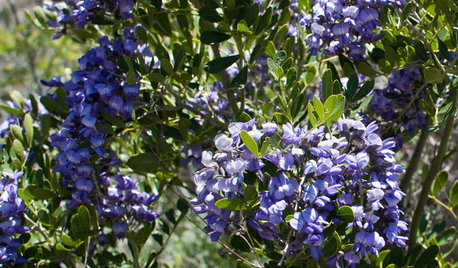

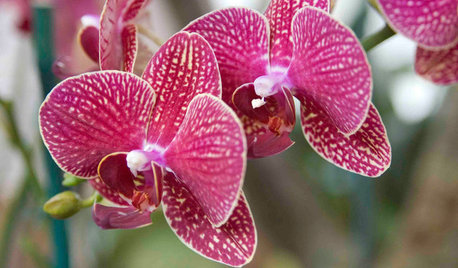
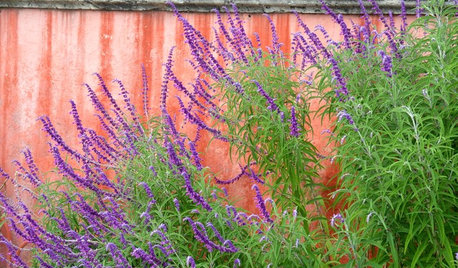

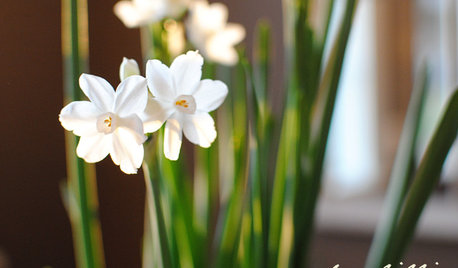






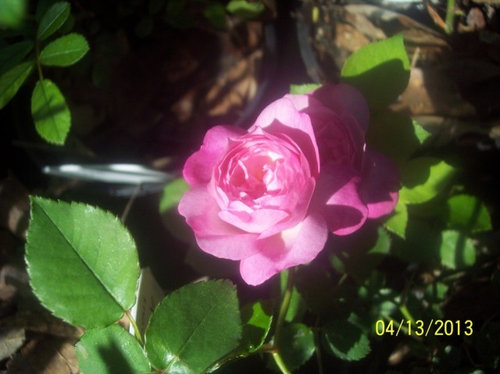
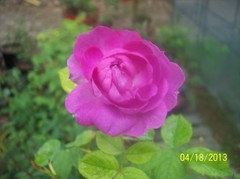
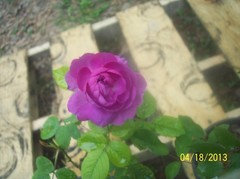
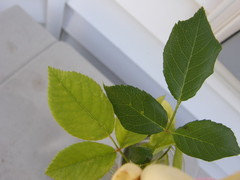
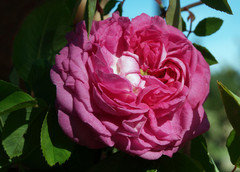
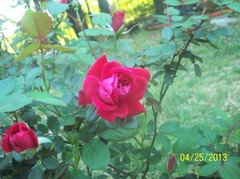
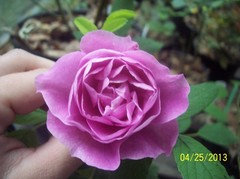
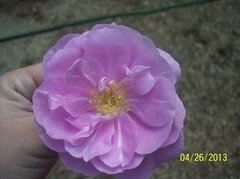
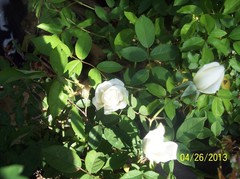

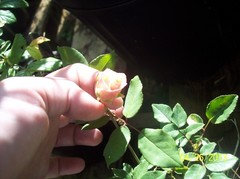

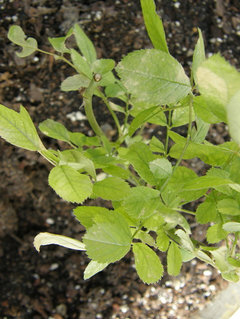
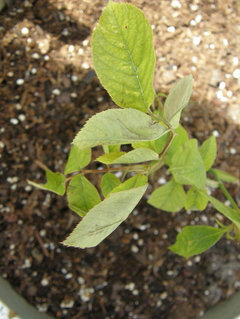





strawchicago z5